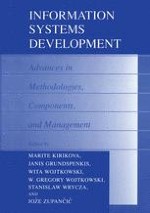This book is the result of the 11 th International Conference on Information Systems Development -Methods and Tools, Theory and Practice, held in Riga, Latvia, September 12-14,2002. The purpose of this conference was to address issues facing academia and industry when specifying, developing, managing, reengineering and improving information systems. Recently many new concepts and approaches have emerged in the Information Systems Development (ISD) field. Various theories, methodologies, methods and tools available to system developers also created new problems, such as choosing the most effective approach for a specific task, or solving problems of advanced technology integration into information systems. This conference provides a meeting place for ISD researchers and practitioners from Eastern and Western Europe as well as from other parts of the world. Main objectives of this conference are to share scientific knowledge and interests and to establish strong professional ties among the participants. The 11th International Conference on Information Systems Development (ISD'02) continues the tradition started with the first Polish-Scandinavian Seminar on Current Trends in Information Systems Development Methodologies, held in Gdansk, Poland in 1988. Through the years this Seminar has evolved into the International Conference on Information Systems Development. ISD'02 is the first ISD conference held in Eastern Europe, namely, in Latvia, one of the three Baltic countries.
